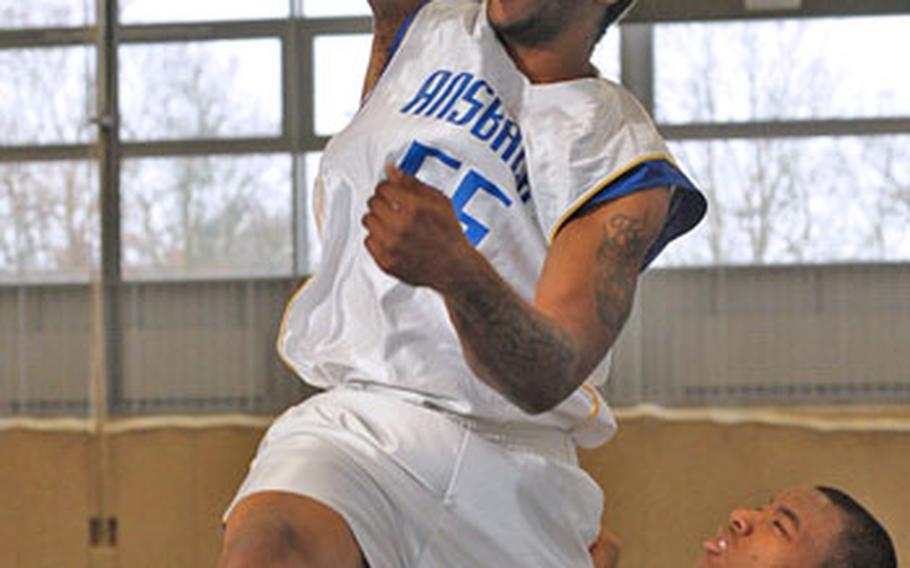
Ansbach's Sam Freeman slams the ball though the hoop in front of Terrence Bartley, Sterling Shephard and Eman Rawls of Naples during a game in February. Freeman was named first team all-Europe for the second straight season in 2009. (Michael Abrams / S&S)
In a game that assigns a line of statistics to every player’s name, picking the best 20 players for the 2009 boys All-Europe basketball team shouldn’t involve much more than a bit of paperwork, should it?
In the States, perhaps, but not over here.
The problem in Europe is that the levels of competition can be as diverse as the schools’ locations, and numbers don’t tell the whole story, according to Baumholder’s Spencer Bean, one of the seven DODDS-Europe boys coaches who picked this year’s all-stars.
“It’s a challenging task to assess players from across Europe who play in completely different circumstances,” Bean wrote in a e-mail to Stars and Stripes. “Some players may be in weaker regions or weaker divisions, but have an outstanding season statistically. Does that mean that they are better than another player who had a good season but did not shine as much because of stiffer competition? That’s difficult to assess.”
Adding to the difficulty is the way the stats are skewed. Star players in Europe, where regional scheduling during the regular season ignores school size, regularly spend large amounts of time on the bench when their teams play outclassed opponents. As a result, their statistics take a hit.
Take first-teamer Jamal Tuck of Aviano. A wondrous shooter and scorer, according to his coach, Kenny McNeely, Tuck averaged 15.8 points per game during a season in which the D-II champion Saints win their first four games by an aggregate score of 235-31. That’s four games in which Tuck got just slightly more playing time than the academically ineligible, and he still scored nearly 16 points per game in his team’s 12-game season.
With the stats often misleading, and with the selection panel of DODDS-Europe athletic director Karen Seadore, Ben Anderson of Rota, Alan Campbell of Lakenheath, Kathy Clemmons of Hohenfels, McNeely of Aviano and Bean consciously rejecting the idea of selecting players to fill position quotas, picking the All-Europe team becomes a matter of gut feelings, discussions and traded impressions.
For some choices, the discussions were undoubtedly short.
Heidelberg guard Chris Frazier made the first team for the third straight time after a season in which he shot 51 percent from the floor and 36 percent behind the three-point arc.
Making the first team for the second consecutive season were Ansbach senior Sam Freeman, a 6-foot-9 pivot with “three full-ride college offers” on the table, according to Cougars coach Marcus George; Bamberg forward Joshua Robinson; and Ramstein forward Brent Schuck. Although picked on the basis of ability rather than position, the four first-team repeaters would be 80 percent of a well-balanced unit to send on to the floor.
“I think we have a very solid first team with a good mixture of guards and big men,” Bean wrote. “We don’t plan out saying we need a certain number of guards and a certain number of forwards, but it worked out that way.”
Heidelberg center J.C. Sharer and Baumholder guard Artrell Davis, second-teamers last year, made the first team; Wiesbaden’s Kiante Clifton made the second team for the second time.
Twelve of Europe’s top 20 made the team for the first time. Most intriguing of those might be the team’s lone freshman, Rota’s Tre’von Owens. The 6-3 Owens, “a natural college wing,” according to Anderson, averaged 24.7 points and 10.7 rebounds in his first varsity season.
Owens and senior Darius Johnson of European champ Sigonella were the lone D-IV players to make the top 20, which included six from Division I, seven from Division II and five from Division III. Baumholder’s Davis is the lone non-D-I/II player on the first team.
Seven seniors filled slots on each 10-man roster; with the exception of Owens and 6-7 Bitburg sophomore Deion Giddens, both second-team choices, the rest were juniors.
But none of that entered into the process.
“We really tried to focus on who we believed were the top players in Europe,” Bean concluded.